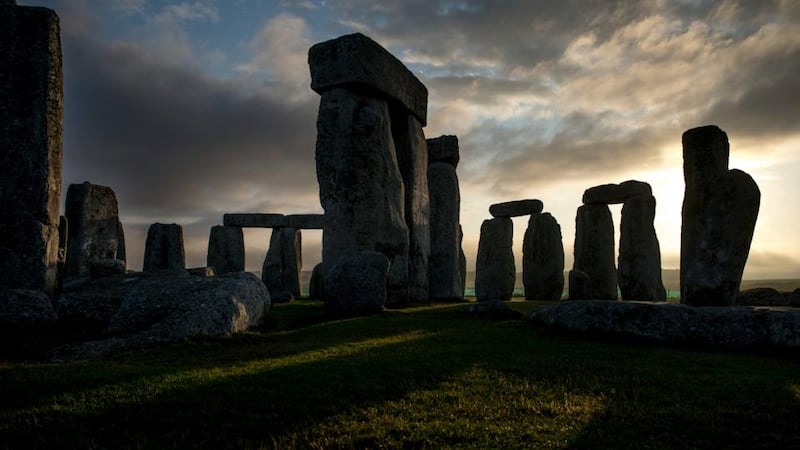Among the antler headdresses, polished axes, ivory and pottery showcased at the Stonehenge exhibition in London’s British Museum runs a strong thread of Irish prehistory. Visitors are enthralled by the lustrous gold and enigmatic tales of how people lived, worked, cooked and made merry around the campfire.
The texture of life in ancient Britain and Ireland as well as across northwest Europe around the time of the construction of Stonehenge, about 5,000 years ago, is unravelled. The "bluestones" used to build the striking monument were dragged on an epic journey from the Preseli mountains in Pembrokeshire across 125 miles of land to Salisbury Plain. The site has long held sway over antiquarians, archaeologists, astronomers and mystics.
In a section of the museum 430 artefacts from the neolithic and bronze ages fill two dimly lit but atmospheric rooms. They are laid out in glass cases, on the walls and even on the ceiling. On loan from museums across Europe, this is the first time such an exotic variety of objects has been assembled together under one roof. The wide parameters place in a broad context links between the countries and recount the human story from 4,000 to 1,000 BC.
As a contrast to the glittering richness of the gold, fleshhooks are a rare curiosity from the Bronze Age
The sun is a recurrent theme as the celestial body was of huge significance in the prehistoric world. Many sites are aligned to sunrise on the winter solstice and the opulent iconography and symbols of sun worship are displayed in the gold pieces.
Centre stage are exquisite examples of elaborate Irish gold jewellery, including the ceremonial Gleninsheen collar, known as a gorget, from the French word gorge meaning "throat". It was discovered by farmer Paddy Nolan in the Burren in 1932. Another gold collar, from Shannongrove bog, Co Limerick, was donated to the Victoria and Albert Museum by Col C K Howard-Bury. A soldier, explorer and botanist from Charleville Castle, Tullamore, Howard-Bury was the leader of the 1921 Mount Everest Reconnaissance Expedition.

Another eye-catching display is a distinctive honeycomb-shaped sun-disc from Kilmuckridge, Co Wexford (circa 2,400-2,000 BC) with two centrally placed holes which may indicate that it was originally attached to clothing. It was thought to have been formed by hammering gold into thin sheets which were then ornamented and polished. Sitting cheek by jowl is a funerary bowl from Sliguff, Co Carlow, a crescent-shaped lunula ("little moon") from Blessington in Wicklow, a pendant from the Bog of Allen and a torc from Tara.
As a contrast to the glittering richness of the gold, fleshhooks are a rare curiosity from the Bronze Age. These long-handled forks made of bronze and wood are believed to have been used to skewer and serve joints of meat. One of them, from a bog in Dunaverney, near Armoy in north Antrim, is intricately decorated with a family of swans and a pair of corvids (rooks or ravens) seemingly locked in a face-off across the length of the staff. This may symbolise cosmological forces or could represent a distinction between birds of the water and birds of the air. Whoever wielded the fleshhook to divide and serve portions of meat is likely to have held a prominent position in the social hierarchy of the community.
An audible highlight, Making Music and Sounding the Charge, features the noise of cattle horns, and is the work of Simon O’Dwyer, co-founder of Ancient Music Ireland. O’Dwyer has composed and registered numerous pieces for Bronze Age horns, Iron Age trumpets, early medieval horns and the bodhrán.
A degree of speculation is linked to the finds and no one will ever have all the answers to the skills, knowledge and sophistication of prehistoric craftspeople
The trumpets on display come from a bronze hoard discovered in Cork and Offaly which follow the form of hollowed cattle horns. The cache comprised weapons, jewellery and feasting paraphernalia of local and continental origin. Tear-shaped rattles, known as crotals, contain a piece of baked clay or a pebble and were blown or shaken to incite warriors to battle and intimidate foes. When blown, original and replica horns produce a melody, while large instruments release a low bass drone – an attraction for museum visitors is an excerpt from O’Dwyer’s Along the Shore recorded in the album Overtone in 2009.
From the Knowth passage tomb in the Boyne Valley an extraordinary carved ceremonial mace-head resembles a human face from the late neolithic. It was made by an unknown artist using a piece of pale-grey flint. The carvings on its surfaces with diamond shapes and swirling spirals form a human face with an eccentric circular gaping mouth.
The exhibition is informed by recent archaeological and scientific discoveries and demystifies some of the puzzlement surrounding Stonehenge. It also fuels the imagination, providing a new perspective on Europe’s earliest ancestors. A degree of speculation is linked to the finds and no one will ever have all the answers to the skills, knowledge and sophistication of prehistoric craftspeople. But the displays open up multiple interpretation while exposing to a wider world many of Ireland’s most outstanding yet little-known treasures from the rich complexity of the past.
The World of Stonehenge runs at the British Museum to July 17th (britishmuseum.org).









